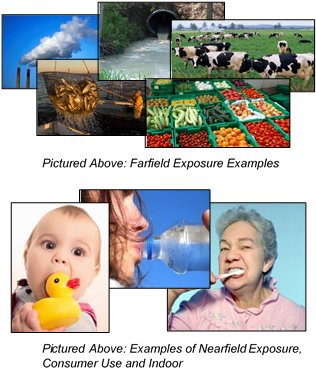Rapid Chemical Exposure and Dose Research

EPA's Rapid Exposure and Dosimetry (RED) research develops methods, data, tools, models, and approaches to rapidly generate exposure and dosimetry estimates for chemicals and mixtures found in commerce and in the environment. Estimates generated through models are evaluated based on relevant monitoring data, including data generated with emerging measurement approaches, and refined based on the evaluation results.
Exposure and dosimetry estimates are combined with hazard data to inform chemical risk assessments.
What is Dosimetry?
Dosimetry refers to the determination or measurement of the amount/dosage of a chemical/substance absorbed by a living organism, usually the human body. Exposure to a chemical can happen through ingestion (by mouth), inhalation (breathing), and dermal (skin) contact.
Research Efforts
Exposure Data
A wide variety of exposure relevant data are necessary to support chemical safety decision making for priority chemicals and mixtures. For many chemicals and product types, there remain critical gaps in exposure information. EPA's RED research collects and curates existing exposure-relevant data, conducts laboratory experiments to collect measured data, harmonizes meta-data (i.e., descriptive data), and expands established databases (e.g., Chemical and Products Database (CPDat)) in order to fill these gaps. Where available, data specific to populations and settings of interest are targeted, including data related to occupational settings, early lifestage, and disproportionately impacted populations to inform environmental justice concerns.
Exposure Models
Chemical exposure evaluations require approaches to estimate exposure for a variety of high-priority pathways, including scenario-specific models particular to consumer products and materials in the indoor environment, as well as occupational, ambient, and ecological pathways. Rapid, automated exposure models (e.g., ExpoCast, SHEDS High-Throughput, Systematic Empirical Evaluation of Models) provide exposure estimates for thousands of chemicals.

- Farfield Exposure Models: Used to predict exposure from chemicals that are released into the outdoor environment through industrial releases. ExpoCast uses “off-the-shelf” models, USETox and RAIDAR, to estimate outdoor environment exposures. These models estimate the average amount of chemical that gets into the air, water, and soil. The estimates from these models are used in combination with the estimates from the nearfield models to make exposure predictions.
- Nearfield Exposure Models: Provide estimates of exposure to chemicals used in consumer products and in-home products. The model used to estimate the range of total chemical exposures in a population is the EPA’s Stochastic Human Exposure and Dose Simulation (SHEDS) model. There is a SHEDS high-throughput model that estimates exposure for thousands of chemicals, and a more precise traditional SHEDS model which needs more input data to make more accurate exposure predictions.
High-Throughput Toxicokinetics
Traditional toxicokinetics (TK) methods require intensive, chemical-specific data from tests involving chemical exposure to living organisms and TK data is unavailable for most chemicals. High-Throughput Toxicokinetic (HTTK) tools fill TK data gaps by using generic, physiologically based toxicokinetic models or empirically based compartmental models.
Non-Targeted Analysis (NTA) Methods
NTA methods are developed to rapidly characterize a broad range of compounds including chemicals of immediate and emerging concern (e.g., per- and polyfluoroalkyl chemicals), real-world mixtures, and substances of unknown or variable composition (UVCB). High-resolution mass spectrometry is the primary NTA tool for identifying previously unknown or understudied chemicals. NTA methods can be applied to any type of sample, including consumer products, environmental matrices, and biological media.
Per- and Polyfluoroalkyl Chemicals
Concern over exposure to and potential health effects of PFAS has increased significantly as more is learned about their environmental presence. Research and data support a wide range of efforts to advance and refine modeling of PFAS exposure, provide a PFAS-specific exposure modeling workflow, and PFAS biotransformation/fate, exposure reconstruction, and dosimetry data. Work is guided by the objectives of EPA’s PFAS Strategic Roadmap to meet the goals of partners.
To address these needs, EPA's RED research works to gather exposure information from consumer products and drinking water monitoring to inform PFAS exposure predictions. Through the use of high-throughput toxicokinetics, our researchers are able to develop PFAS dose estimates.
In Vitro-In Vivo Extrapolation (IVIVE)
Over the last several decades, the science of toxicology has undergone a transformation from observational to predictive science. Some cutting edge predictive methods are advancing beyond the traditional exploratory research stage and are beginning to gain acceptance for chemical risk assessment. IVIVE enables use of high throughput toxicity assays as an alternative to animal testing by comparing them to results found in traditional in vivo toxicity tests to establish their validity. Eventually this could replace whole animal testing, saving time and resources.
Tools and Resources
Chemical Exposure (ChemExpo) Knowledgebase
- ChemExpo: A new, publicly accessible data search and visualization tool for exploring chemical data relevant to exposure assessment that has been curated from public documents. ChemExpo focuses on data collected by EPA about how chemicals are used in commerce and how they occur in consumer and industrial products. The ChemExpo team actively works to curate these data to harmonize consumer and occupational product categories, chemical functional categories, and exposure-relevant keywords, as well as to substance identifiers (DTXSIDs) used by EPA and the CompTox Chemicals Dashboard. These curated data are collectively known as EPA's Chemicals and Products Database (CPDat).
Consumer Product Information
- Chemical and Products Database (CPDat): Consumer use information from collating electronic material safety data sheets (MSDS), analyzing consumer product purchasing behavior and data resulting from testing consumer products for the presence of chemicals. Data is accessible through the CompTox Chemicals Dashboard.
Stochastic Human Exposure and Dose Simulation (SHEDS) Model
- SHEDS High-Throughput: Models population-level distributions of exposure to near-field chemical sources. SHEDS-HT can produce exposure estimates for thousands of chemicals. SHEDS-HT accounts for multiple exposure routes, scenarios, and pathways to understand the total exposure while retaining population and life stage information.
Systematic Empirical Evaluation of Models (SEEM)
- SEEM R Package
- Systematic Empirical Evaluation of Models User Guide (Training/ Resource web page)
High-Throughput Toxicokinetics
- Httk R Package
- Httk Package Reference Manual (v.2.1.0)
- Presentation recording: High Throughput Toxicokinetic Modeling (video)
